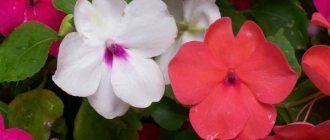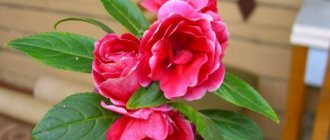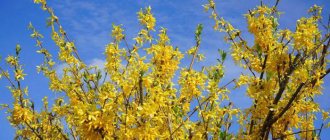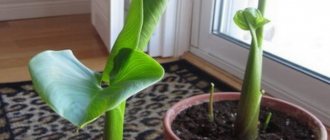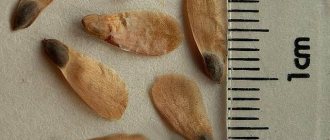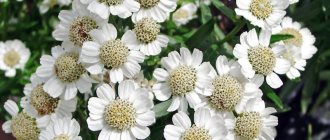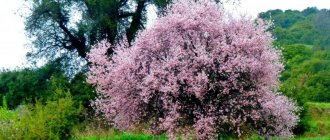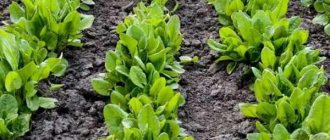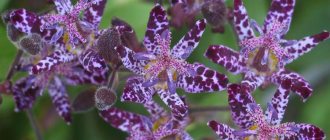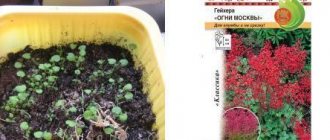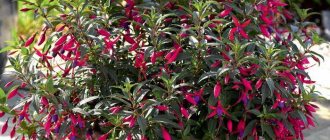Description
New Guinea balsam grows up to 30-50 centimeters in height.
The root system is powerful and well branched.
The stem is strong and thicker than other types of balsams.
The leaves are lanceolate, up to 5 centimeters wide, with short petioles, reaching a length of up to 10 centimeters. The leaf blades have a serrated edge and prominent deep veins. The color of the leaves varies from light green to dark green with a burgundy tint.
The flowers are five-petaled, up to 5 centimeters in diameter, with elongated shoots on the sides. They bloom alone or in small inflorescences.
After pollination of flowers, oblong seed pods , which, at maturity, burst when touched and release their seeds.
Characteristics of the species and varietal diversity of balsam
Representatives of the New Guinea species are distinguished by a strong stem, dense leaf plates, compact bush size (up to 30-50 cm) and the ability to flower all year round.
The leaves are arranged whorled on the stem. They are attached using shortened petioles. The shape of the plates is broadly lanceolate with a finely serrated edge. The central vein is clearly visible on the leaves. In most varieties it is recessed deep into the plate. The color of the leaves is represented by shades of green. In some hybrids it is combined with burgundy red or yellow.
Flowers have decorative value. They are quite large, in some varieties reaching 8 cm in diameter. The flower shape is five-petaled with an elongated curved spur. Flowers can be arranged singly or collected in axillary inflorescences.
There are 3 groups of hybrids of this species:
- dwarf bushes up to 20 cm in height with small flowers;
- spreading bushes of medium size, intended for growing in a hanging form;
- tall hybrids with erect stems reaching up to 90 cm.
The most popular varieties are:
- Harmony – very branched stems and large flowers in 14 colors.
Harmony - Divaro - compact bushes with medium-sized flowers. The series includes 6 colors.
Divaro
- SunPatiens Spreading White - variegated compact bushes with snow-white flowers. SunPatiens Spreading White
- Jungle Rain - the series is distinguished by pastel tones of the color of the petals.
Jungle Rain
- Rainforest Exotic - two-color hybrids.
Rainforest Exotic
- Macarena - bright orange flowers against a background of bronze leaves.
Macarena
The duration of balsam flowering depends on care. If all standards are followed, the plant can bloom all year round.
Caring for New Guinea balsam
Impatiens, including the New Guinea species, are quite unpretentious plants. However, if unfavorable factors arise, they lose their decorative appearance. In this regard, their successful indoor cultivation requires compliance with certain conditions.
Planting and soil
There is a wide variety of varieties of balsam of the New Guinea species, which differ in appearance: shades of leaves and colors of flowers, stem height. Many of the varieties are suitable for indoor growing.
Compact small and medium varieties are intended for growing in pots, while large tall varieties are best grown in flower beds as garden flowers. However, in the summer, smaller varieties of “impatiens” can be planted in open ground or taken outside. This causes a good reaction in the form of luxurious flowering.
New Guinea balsam requires a breathable substrate of loose consistency with a pH level of 5.8-6.2 , as well as a drainage layer.
Pot
Be sure to have drainage holes in the pot. For young balsam, dishes with a diameter of 10-12 centimeters are suitable.
Transfer
Due to rapid development, balsam loses its decorative effect after 2 or 3 years. Therefore, adult plants do not need to be transplanted, but renewed by cuttings.
Young flowers need replanting, and it can be done at any time of the year, since balsam does not need a dormant period.
Watering
You should water moderately, but do not forget that the flower readily absorbs moisture.
When watering, you need to avoid getting water on the lower leaves and excess moisture, which can stagnate and lead to rotting of the roots and leaves.
Air humidity
Air humidity in the plant’s habitat should not exceed 60-70% and fall below 40%. In winter, in conditions of increased dry air, it is recommended to spray twice during the day, since a lack of humidity causes the leaves to fall off. You can also use a method such as placing the pot on a tray with moistened expanded clay.
Thermal mode
New Guinea balsams like a moderately warm atmosphere between 17-24 degrees Celsius. Sudden changes in temperature are extremely undesirable, therefore, in the summer, indoor plants are allowed to stay outdoors only under stable warm conditions, when the temperature at night does not fall below the daytime temperature by more than 5 degrees.
Balsam does not tolerate drafts and even short-term hypothermia
Light mode
Impatiens need fairly intense lighting without direct sunlight. Good location - windows facing east and west.
If there is insufficient flowering in the cold months of the year, it is recommended to use additional lighting with special lamps.
Wintering
The plant tolerates the winter season well if suitable conditions are created for it:
- Moderate watering;
- Warm room temperature;
- Spraying when there is a lack of humidity;
- Additional lighting with artificial light.
For connoisseurs of the beauty of balsams, we have prepared materials with descriptions and information on growing varieties such as Garden, Wallera, Camellia and Terry.
Home care
Impatiens are unpretentious plants, but if the rules of care and maintenance are violated, they quickly lose their decorative qualities.
Watering and air humidity
The plant loves moisture, but despite this, it needs to be watered moderately. When watering, try to avoid excess moisture, which can lead to stagnation and, as a result, rotting of the root system and leaves. In addition, moisture on the lower leaves of the flower can also destroy the ornamental bush.
The air humidity in the room should be no more than 60−70%, but not lower than 40%. In winter, when the air becomes dry due to operating heating radiators, it is recommended to carry out regular spraying (2 times a day), otherwise the lack of humidity will lead to leaf fall. Another method you can use is to place the container with the plant on a tray filled with moistened expanded clay.
Thermal and light conditions
New Guinea balsam does not tolerate too high temperatures. The optimal indicator for it will be +22−25 degrees during the daytime and +15−19 at night. In autumn, when natural daylight hours are shortened, the bushes need to be provided with additional lighting using special lamps. Plants need light 14 hours a day.
Fertilizer application
The flower should be fed no more than twice a month, and the fertilizers should not be complex, but special potassium fertilizers intended for flowering plants. Be careful with nitrogen-containing mixtures; an excess of this element can lead to an abnormal growth of green mass and a complete stop in the flowering process.
Diseases and pests
In most cases, diseases of indoor balsam occur due to violation of the rules of care. For example, root rot appears due to regular waterlogging of the soil or excessive watering. The same factors cause rotting of the base of the stem.
Impatiens are very popular with insect pests such as whiteflies, aphids and spider mites. To get rid of these parasites, you need to systematically wash the flower in the shower, using only warm water. Severe infestations can be treated with special chemicals that can be purchased at a flower shop.
Preventive actions
To prevent such problems from occurring, the plant must be carefully cared for. As a rule, the condition of the plant returns to normal after the restoration of appropriate conditions. But this does not apply to those cases when the disease has already entered an irreversible phase, for example, an advanced stage of root rot.
Regularly washing the leaves with warm water will help prevent the appearance of pests.
Transplanting a plant
Indoor New Guinea balsam from seeds or cuttings is one of the perennials that can delight you with gorgeous flowering for 3-4 years in a row, after which they lose their decorative properties and require renewal. Therefore, it is not worth replanting old bushes; it is better to replace them with young ones, using the cutting method or growing a flower from seeds.
Since balsams do not have a dormant period under indoor conditions, they can be propagated at any time of the year. As for young plants, transplantation is carried out as follows:
- Place a layer of drainage in the prepared pot, which should occupy about ¼ of the total volume of the planting container;
- fill the container to the top with nutritious soil and moisten well with settled water at room temperature;
- before removing the plant from the old pot, the soil in it should also be watered abundantly;
- before planting, the roots of the flower must be carefully examined and, if necessary, damaged areas must be trimmed;
- the bush is transplanted into a new pot along with a lump of earth.
Preparing for winter
Since indoor balsam does not have a dormant period, no special preparation for winter is required. It is only necessary to create conditions suitable for this time of year, which require the following:
- at low air humidity, plants must be sprayed regularly;
- in the room where balsam is kept, the air temperature should be comfortable for this type of plant;
- It should be watered moderately, and it is also necessary to provide the flower with additional lighting.
Growing balsam at home is not so difficult. You just need to follow simple planting rules, as well as recommendations for growing and caring for “touch-me-nots”. And then this unique, constantly flowering bush will delight you with its beautiful appearance for 3-4 years.
Reproduction methods
New Guinea balsam is successfully propagated by cuttings. In order to propagate it, the upper part of the plant with several nodes is used. The cuttings are placed in water or rooted in wet sand. Root growth occurs over 15-20 days. Then the young flower is planted in a pot with a diameter of 10-12 centimeters. The soil used is universal. Drainage is required.
Propagation from seeds seems to be a more difficult method due to the risk of low seedling germination and low survival rate of weak shoots.
Growing Balsam New Guinea from seeds
Before starting cultivation, it is recommended to make sure that the purchased seeds are fresh, since they are good for 6 months and will not sprout if they take longer. Growing stages:
- The seeds are sown in a shallow container filled with a peat-based substrate;
- The substrate is moistened;
- The container with the seeds is placed in a warm, wind-free place and covered with film to create a greenhouse effect;
- Seeds germinate in 5-8 days;
- After the formation of a pair of leaves on the sprouts, a dive is made;
- Young plants are transplanted into pots 4-5 weeks after sowing the seeds.
Trimming
Pruning balsam is an undesirable procedure, as it leads to the formation of keratinized stumps that disrupt the integral decorative appearance. For lush branching, it is recommended to pinch out young shoots.
Bloom
Touch-me-not has no clearly defined periods of flowering and dormancy.
Everything depends on the state of the environment. It is capable of blooming all year round under appropriate decent conditions. Summer time is characterized by abundant flowering , and when in an open garden, New Guinea balsam simply “drowns” in beautiful flowers.
Reproduction and transplantation of New Guinea balsam at home
The plant is propagated in two ways: vegetative (cuttings) and generative (seeds). Most gardeners prefer the vegetative propagation method.
Cuttings
The best time for cuttings is March. At this time, a new round of vegetation begins. March layerings will bloom this year. Unlike the seed route, propagation by cuttings allows you to preserve the varietal characteristics of the mother plant, which is important for the propagation of rare hybrids. Propagation of balsam by cuttings consists of several stages:
- The apical shoot with three internodes is cut from an adult plant. The lower leaves are removed. There should be no buds or inflorescences on the shoot intended for cuttings.
- The cuttings are rooted in a container with water or a wet mixture of peat (1/4), vermiculite (1/4) and perlite (1/2). The water is periodically replaced with fresh water.
Propagation by cuttings
- The cuttings are left in a warm room with bright, diffused light.
- To speed up the rooting process, cover the container with film or a transparent cap.
- Cuttings placed under film need daily ventilation. Layers that take root in the soil must be additionally sprayed on a daily basis.
In water, balsam takes root in 10-14 days, in soil - after a week. After rooting, the film is removed and the cuttings are left to strengthen for 2-3 weeks. They are then planted as mature plants.
Seeds
The advantage of seed propagation is a large number of new specimens. But this method also has disadvantages. Firstly, the seeds do not retain varietal characteristics. Secondly, they do not have very good germination.
You can grow a plant from seeds as follows:
- Balsam seeds are pre-soaked in warm water.
- A couple of hours after soaking, the seeds are mixed with sand and placed in a container with wet peat.
Balsam seeds
- The container is covered with film and left in a warm, bright place.
- Seedlings require daily ventilation and moisture. Instead of watering, the soil is sprayed with a spray bottle so as not to wash out the seeds.
- Shoots appear 2-3 weeks after sowing. As soon as this happens, the film is removed.
When the sprouts reach 5 cm, they are transplanted into the usual soil for balsam.
Transplantation and planting
The flower has a very developed root system, so replanting is carried out every year. It is advisable to carry out the procedure in the spring, before the period of budding and flowering. Flower transplantation involves the following steps:
- The plant is carefully removed from the old pot and freed from the old soil.
- The roots are carefully inspected for rot. If there is one, the affected areas are cut off and treated with a fungicide solution.
Transfer
- A quarter of the new pot is filled with drainage (expanded clay, pebbles, broken bricks).
- A little soil is poured onto the drainage layer. A flower is placed on top and its roots are straightened.
- The voids of the pot are filled with the remaining soil. The soil is trampled down a little and moistened.
The first planting is no different from the procedure for transplanting a flower. For young plants, select pots with a diameter of no more than 10 cm. The plant is comfortable in nutritious and loose soil. Most often, balsams are planted in universal soil with the addition of vermiculite.
Fertilizer and feeding
To feed the flower, complex fertilizers with a high potassium content are used.
The mixture for fertilizing balsam should not contain nitrogen, because it leads to a sharp decrease in flowering due to an increase in foliage.
The plant is fed 2 times a month. When a period of intense flowering begins, fertilizing is reduced to 1 time.
Growth rate
Balsam "New Guinea" grows quite quickly. You need to ensure that the plant develops not so much in height as in width. When the shoots are pinched, the balsam grows thickly and becomes decorative.
Lifespan
The duration of active growth and flowering lasts up to 3 years in indoor conditions, then the plant needs to be cut and replanted.
When grown in open ground, balsam turns into an annual plant.
Smell
Impatiens flowers do not have a specific odor.
General information about the plant
Impatiens is a perennial ornamental herbaceous plant that belongs to the balsam family. This flower is popularly known as “touch-me-not.” This is due to the fact that balsam fruits, which contain seeds inside them, burst when ripe when touched lightly. In Russia and Europe, the hybrid variety New Guinea balsam is valued for its large and beautiful flowers and compactness of the bush, subject to constant pruning and care. The species is native to tropical and subtropical forests of America, Asia and Africa.
- The height of the plant, depending on the variety and place of growth, can reach from 30 to 50 cm.
- New Guinea balsam grows as a bush with well-branched stems, which, unlike other species, have a full and strong structure.
- The leaves are densely located at the tops. They have an oblong oval shape, tapering towards the ends. The edges are serrated, the veins are pronounced, the petioles are short. Leaf color varies from light green and green to brown-red.
- The flowers are large, can reach 5-7 cm in diameter. The petals are curly, have elongated lateral growths, their color depends on the variety and can be one-color or two-color with patterns. The buds are located on the tops of the stems, one or several in an inflorescence.
It has a strong root system that grows and branches well.
The flowering period is long and, depending on the place of growth and climatic conditions, can last several months. For potted indoor representatives of balsam, this period can last up to 10 months.
After pollination, fruits are formed in place of the flowers.
They are an oblong box, the outer part of which is divided by several ribs. Once ripe, the fruit opens when touched for the first time and releases its seeds. This is how the plant reproduces in nature.
Diseases and pests
diseases can only be caused by incorrect content:
- Low air humidity causes leaves to fall;
- Exposure to direct sunlight causes leaves to yellow;
- Excess moisture in the soil causes root rot;
- Lack of feeding deprives flowering or causes its scarcity.
To prevent such “everyday” diseases, it is necessary to carefully care for the plant. Usually, the resumption of proper maintenance brings the condition of the flower back to normal, except in cases where irreversible processes have occurred, for example, advanced root rot.
Impatiens are susceptible to pest . Most often it is attacked by spider mites, as well as whiteflies and aphids.
It is recommended to wash the leaves of the plant with warm water to reduce the risk of uninvited visitors appearing on them. If the disease has already taken over the plant, then you will have to use effective chemicals designed specifically to combat certain pests.
New Guinea hybrid varieties of balsam are distinguished by brighter external characteristics from their relatives: larger flowers and stems. Such differences are increasing the popularity of breeding these plants.
Flower growers are especially pleased with the fact that this species is unpretentious in care and develops both indoors and in open garden beds.
A little about this amazing plant
The herbaceous plant that we want to tell you about belongs to the genus Impatiens, which was not named so by chance. All its representatives have one unique feature - at the slightest touch to their seed pod, it bursts with a bang, and the seeds scatter within a radius of 2 meters.
The genus of balsams is numerous, it includes about 500 species of plants, including New Guinea balsam. Today we will talk about it in more detail.
New Guinea balsam.
This plant is a real miracle, because if you provide it with good care, it will delight you with its flowering for six or even eight months a year. New Guinea balsam differs from other balsams in its thick stem, more powerful leaves and flowers. It has a more compact size, which allows it to be grown in small rooms.
Guinea balsam is more resistant to pathogens and parasites, and is more hardy. As a result of the painstaking work of breeders, flower growers are presented with different species that differ in the color of leaves and flowers, as well as the duration of their flowering. Caring for them is the same as for most balsams.
Photo
Next you will see a photo of New Guinea Impatiens:
Reviews
Natalya, 37 years old, Novorossiysk: “I purchased the flowering Guinea balsam at the garden center. When purchased, the plant already had many buds. The seller recommended it as a flower that will bloom throughout the year. I have had it for three years now and it blooms beautifully and almost constantly. I try to take proper care of it so that the leaves don’t wilt, and he responds with gratitude. This flower became my pride, all my friends bought this variety for themselves.”
Anna, 56 years old, Moscow: “I am an amateur flower grower and cannot pass by display cases with flowers, even when I do not intend to purchase them. That time, I also stopped just to look at the flowers, and suddenly my attention was attracted by a beautiful blooming indoor balsam. Turning to the seller, I found out that this was Guinea balsam; she showed them three varieties, which differed in shades. I bought them all and never regretted it. Surprisingly, this plant turned out to be completely unpretentious in the growing process. The only thing it needs is systematic watering. The flower is very colorful, bright and beautiful, blooms throughout almost the whole year. I recommend flower growers to add this plant to their collection.”
Diseases, pests and treatment of New Guinea balsam
If you follow the growing recommendations, pest damage to balsam rarely occurs. To prevent most diseases, it is enough to regularly wipe the leaves and stems with a napkin soaked in warm water, empty the water from the trays, and remove dried and damaged leaves.
The following insects most often damage balsam:
- Aphid. Can lead to rapid death of the plant. Most often it damages young shoots and forms a sticky layer on the affected surface. Numerous colonies of small (2-4 mm) bugs of various colors (black, white, green) are visually detected. To combat this pest, you need to mechanically remove insects and wash the plant with soapy water or organophosphorus preparations.
Impatiens pests
- Spider mite. This is a very small insect - about 1 mm long, and can have a gray, brown, brown, or green color. In the initial stages of the infection, yellow spots form on the leaves. If the mite multiplication is not stopped, the leaves dry out and fall off. Quite often a white coating appears, somewhat reminiscent of a cobweb. When fighting spider mites, it is important to treat not only the plant itself, but also the surfaces around the plant - windows, window sills, walls.
- Whitefly. Outwardly it resembles a snow-white butterfly, but its size is no more than 3 mm. When indoor flowers are infected with whitefly, black spots and a sticky, shiny coating appear on the leaves. To destroy this parasite, chemical agents are used - Admiral, Aktara, Bankol, Commander, Oberon.
It will also be interesting: Alsobia - caring for a houseplant at home?
